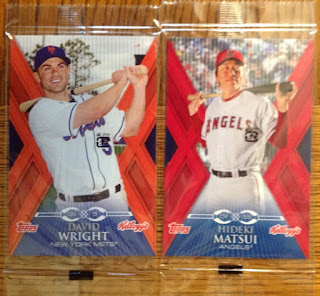There are a few reasons to talk about the backs of the Kellogg's cards from the 1980s before showing 1970s backs.
1. I read the 1970s ones immediately after getting the card from Frosted Flakes. In the later years I ended up buying the sets from someone at a flea market. Then I didn't spend time reading each card back.
2. Some of the years have lots of text and 1981 - 1982 certainly have lots to add about players, even if they've had long careers like Yaz, Rose, etc.
3. The 1981s that I mentioned a while back proved to be a fun project for me so I might as well continue it.
I'm now going to go through the 1983 set. The cards are small and the backs are oriented vertically, so reading it is a challenge for me. The set contains 60 cards and I will once again go through them one nine-card sheet at a time. Today, I will read cards 55 - 60. If there is repeating information from another year I will still mention it if it is interesting. Maybe the kid who got this card didn't have the earlier one?
Card #60 - the last card in the last regular-issue Kellogg's set.
Bobby Grich ended up being the last card. I wonder when Kellogg's decided to halt production before the 1984 set.
Grich's card says he is the exception to the rule that power hitters are born not made. He had low homer totals for nine years and then hit 30 homers in 1979. In the strike-shortened 1980 season he tied for the league lead in homers. I couldn't believe it so I looked it up. He did, but he only finished 14th in the MVP voting.
Card #59 - Bill Buckner
He finished in the top five in batting in the NL for the third consecutive season. His limp is a result of an ankle injury as the result of an attempted stolen base in 1975. Stolen bases still don't appear as a statistic on the card backs.
Not on the card - if his ankle were injured today he'd be back without the limp. He stole 183 career bases with a career high of 31.
Card #58 - Mike Schmidt
Lots of details about his home run titles, RBIs, playoff and All-Star Game success. It then mentions that he'd like to remain a Phillie for his entire career. He signed a mult-year contract worth one million dollars per year at the end of 1981.
Not on the card - he did remain a Phillie. Now a player who makes that kind of money only comes into the game when the team is winning big or losing big.
Card #57 - Dave Concepcion
Shortstops are generally stereotyped as good-field, no-hit role players. He is mentioned as an exception to that.
Card #56 - Carlton Fisk
Tony LaRussa called Fisk "the manager on the field". He cam back to hit his famous 1975 homer in a season shortened by a broken arm.
Not on the card - he broke his arm during a spring training game.
Card #55 - Gary Carter
He became the highest paid player in baseball history when he signed for $15 million over seven years. He turned down lots of college scholarship offers to sign with Montreal in 1972.
Of the six players listed today, three of them listed hunting as their hobby. Two listed golf and one listed sports and woodworking. Tomorrow there will be more varied hobbies with cards #46 - 54.






































